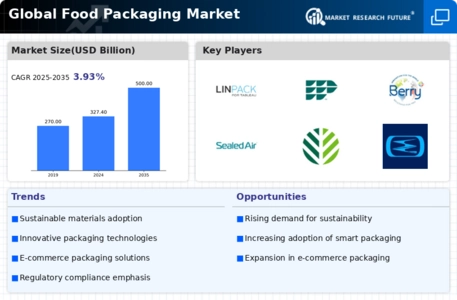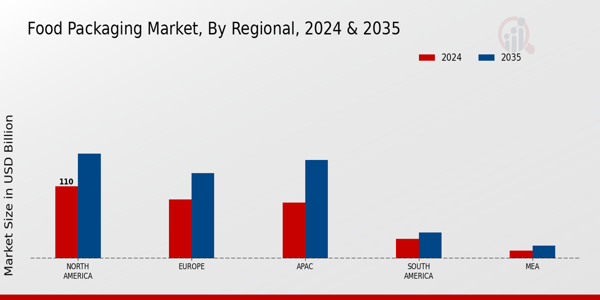Growing Demand for Sustainable Packaging
The Global Food Packaging Market Industry is increasingly influenced by the rising consumer demand for sustainable packaging solutions. As environmental concerns gain prominence, manufacturers are compelled to adopt eco-friendly materials and practices. This shift is evident in the growing use of biodegradable and recyclable materials, which not only reduce waste but also appeal to environmentally conscious consumers. For instance, companies are now integrating plant-based plastics into their packaging lines, which aligns with sustainability goals. This trend is projected to contribute significantly to the market's growth, with the industry expected to reach 327.4 USD Billion in 2024.
Increasing Urbanization and Changing Lifestyles
Urbanization is a critical driver of the Global Food Packaging Market Industry, as it leads to changing consumer lifestyles and preferences. With more people living in urban areas, there is a growing demand for convenience foods that require efficient packaging solutions. This trend is reflected in the rising consumption of ready-to-eat meals and snacks, which necessitate innovative packaging that ensures product freshness and safety. Consequently, food manufacturers are adapting their packaging strategies to cater to this demographic shift, thereby fueling market growth. The industry is expected to witness a compound annual growth rate of 3.92% from 2025 to 2035.
Regulatory Compliance and Food Safety Standards
The Global Food Packaging Market Industry is significantly influenced by stringent regulatory frameworks and food safety standards. Governments worldwide are implementing regulations to ensure that food packaging materials are safe and do not pose health risks to consumers. Compliance with these regulations is essential for manufacturers, as non-compliance can lead to severe penalties and loss of consumer trust. As a result, companies are investing in high-quality materials and processes that meet safety standards. This focus on compliance not only enhances consumer confidence but also drives innovation in packaging solutions, contributing to the overall growth of the market.
Technological Advancements in Packaging Solutions
Technological innovations play a pivotal role in shaping the Global Food Packaging Market Industry. Advancements such as smart packaging, which incorporates sensors and indicators, enhance food safety and quality. These technologies allow for real-time monitoring of food conditions, thereby reducing spoilage and waste. Moreover, automation in packaging processes improves efficiency and reduces labor costs. The integration of these technologies is likely to attract investments and drive market growth. As a result, the industry is anticipated to expand significantly, with projections indicating a market size of 500 USD Billion by 2035.
Rising E-commerce and Online Food Delivery Services
The surge in e-commerce and online food delivery services is reshaping the Global Food Packaging Market Industry. As consumers increasingly opt for online shopping and food delivery, there is a heightened demand for packaging that ensures product integrity during transit. This includes the use of durable and protective materials that can withstand shipping conditions. Additionally, the need for attractive packaging that enhances the unboxing experience is becoming more pronounced. This trend is expected to propel market growth, as businesses adapt their packaging strategies to meet the evolving demands of online consumers.























Leave a Comment